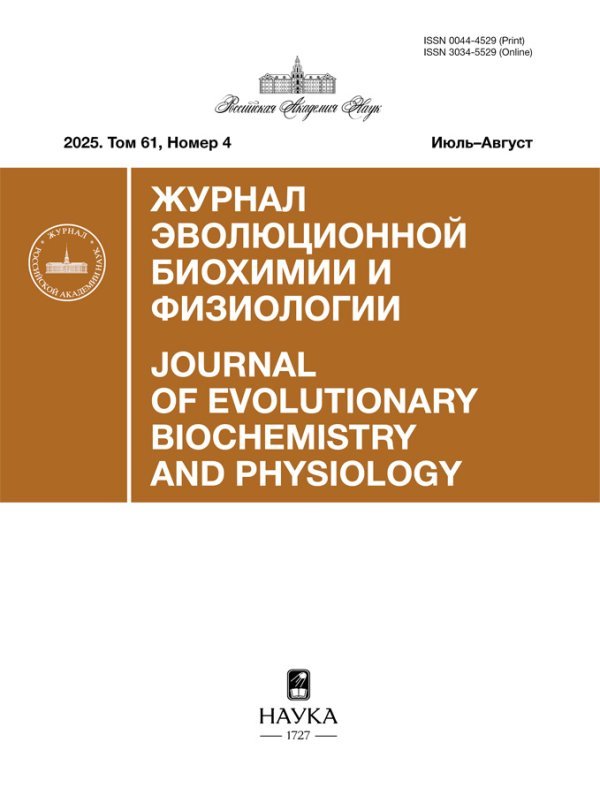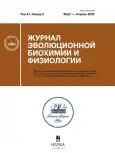The role of kisspeptin in the regulation of emotional states in modeling acute stress disorder in a vertebrate species
- Authors: Golts V.A.1, Lebedev A.A.1, Pyurveev S.S.1,2, Perova A.P.1,3, Bychkov E.R.1,4, Tissen I.Y.1, Tsikunov S.G.1, Shabanov P.D.1
-
Affiliations:
- Institute of Experimental Medicine
- Saint Petersburg State Pediatric Medical University
- Saint Petersburg State University
- Kirov Military Medical Academy
- Issue: Vol 61, No 2 (2025)
- Pages: 128-140
- Section: EXPERIMENTAL ARTICLES
- URL: https://edgccjournal.org/0044-4529/article/view/685053
- DOI: https://doi.org/10.31857/S0044452925020063
- EDN: https://elibrary.ru/IFODHX
- ID: 685053
Cite item
Abstract
In acute stress disorders, depressive, anxiety-phobic states and sexual dysfunctions are observed, which are poorly amenable to treatment. Neuropeptides of the kisspeptin group have been proposed for the correction of these disorders. We have previously shown the effect of kisspeptin analogs on the activation of sexual behavior in a model of acute stress disorders. The aim of the present work was to determine the role of kisspeptin in the regulation of emotional behavior following the acute stress of predator presentation in a range of vertebrates. The effects of fish presentation of the predator Hypsophrys nicaraguensis to Danio rerio and of tiger python presentation to Wistar rats were investigated. Similarly to the behavior of rodents, fish showed manifestations of negative emotional states: frising on the bottom and decreased motor activity. Administration of phenazepam, paroxetine, or kisspepin 10 ameliorated the effects of predator presentation in Danio rerio: increased movement to the top of the tank; decreased time at the bottom of the tank. Unlike phenazepam, kisspeptin 10 did not reduce anxiety-phobic reactions in the elevated plus maze in modeling of acute stress disorder in rats, while showing disinhibitory and antidepressant effects in the Porsolt test similar to the action of serotonin reuptake inhibitor paroxetine. Data on the unidirectional effects of kisspeptin 10 and paroxetine in Danio rerio and Wistar rats support a role for kisspeptins in modulating serotonin-dependent behavior in a model of acute stress disorder. The data support the hypothesis that kisspeptins are involved in relieving anxiety-phobic states while maintaining emotional aspects of reproductive behavior such as sexual motivation, territorial behavior, and arousal in a range of vertebrates. The work shows promise for the introduction of Danio rerio into preclinical and translational research protocols in the study of acute stress disorders.
Keywords
Full Text
About the authors
V. A. Golts
Institute of Experimental Medicine
Email: aalebedev-iem@rambler.ru
Russian Federation, Saint Petersburg
A. A. Lebedev
Institute of Experimental Medicine
Author for correspondence.
Email: aalebedev-iem@rambler.ru
Russian Federation, Saint Petersburg
S. S. Pyurveev
Institute of Experimental Medicine; Saint Petersburg State Pediatric Medical University
Email: aalebedev-iem@rambler.ru
Russian Federation, Saint Petersburg; Saint Petersburg
A. P. Perova
Institute of Experimental Medicine; Saint Petersburg State University
Email: aalebedev-iem@rambler.ru
Russian Federation, Saint Petersburg; Saint Petersburg
E. R. Bychkov
Institute of Experimental Medicine; Kirov Military Medical Academy
Email: aalebedev-iem@rambler.ru
Russian Federation, Saint Petersburg; Saint Petersburg
I. Y. Tissen
Institute of Experimental Medicine
Email: aalebedev-iem@rambler.ru
Russian Federation, Saint Petersburg
S. G. Tsikunov
Institute of Experimental Medicine
Email: aalebedev-iem@rambler.ru
Russian Federation, Saint Petersburg
P. D. Shabanov
Institute of Experimental Medicine
Email: aalebedev-iem@rambler.ru
Russian Federation, Saint Petersburg
References
- Meczekalski B, Niwczyk O, Bala G, Szeliga A (2022) Stress, kisspeptin, and functional hypothalamic amenorrhea. Curr Opin Pharmacol 67: 102288. https://doi.org/10.1016/j.coph.2022.102288
- Mills EGA, O'Byrne KT, Comninos AN (2019) Kisspeptin as a behavioral hormone. Semin Reprod Med 37(2): 56–63. https://doi.org/10.1055/s-0039-3400239
- Mills EGA, Dhillo WS, Comninos AN (2018) Kisspeptin and the control of emotions, mood and reproductive behavior. J Endocrinol 239(1): R1–R12. https://doi.org/10.1530/JOE-18-0269
- Гольц ВА, Лебедев АА, Ереско СО, Айрапетов МИ, Пюрвеев СС, Бычков ЕР, Байрамов АА, Лебедев ВА, Шабанов ПД (2024) Влияние кисспептина костистых рыб KISS1 и аналогов кисспептина млекопитающих на коммуникативное поведение Danio rerio, вызванное социальной изоляцией. Обз клин фармакол лек тер 22(2): 191–203. https://doi.org/10.17816/RCF625892
- Tsukamura H, Ozawa H, Lehman MN (2024) Kisspeptin and mammalian reproduction. Peptides 181: 171297. https://doi.org/10.1016/j.peptides.2024.171297
- Гольц ВА, Лебедев АА, Блаженко АА, Лебедев ВА, Казаков СВ, Байрамов АА, Хохлов ПП, Бычков ЕР, Пюрвеев СС, Шабанов ПД (2023) Анксиолитическое действие аналогов кисспептина у Danio rerio. Обз клин фармакол лек тер 21(2): 159–169. https://doi.org/10.17816/RCF321976
- Comninos AN, Wall MB, Demetriou L, Jayasena CN, Colledge WH, Bassett P, Bloom SR, Venkitaraman R, Noreika V, Zeki S, Dhillo WS (2017) Kisspeptin modulates sexual and emotional brain processing in humans. J Clin Invest 127(2): 709–719. https://doi.org/10.1172/JCI89519
- Гольц ВА, Лебедев АА, Блаженко АА, Лебедев ВА, Казаков СВ, Байрамов АА, Хохлов ПП, Бычков ЕР, Пюрвеев СС, Шабанов ПД (2023) Сравнение анксиолитического действия кисспептинов млекопитающих и костистых рыб у Danio rerio. Психофармак биол наркол 14(2): 85–96. https://doi.org/10.17816/phbn501442
- Somoza GM, Mechaly AS, Trudeau VL (2020) Kisspeptin and GnRH interactions in the reproductive brain of teleosts. Gen Comp Endocrinol 298: 113568. https://doi.org/10.1016/j.ygcen.2020.113568
- Nie Z, Zhao N, Zhao H, Fu Z, Ma Z, Wei J (2023) Cloning, expression analysis and SNP screening of the kiss1 gene in male Schizothorax biddulphi. Genes 14(4): 862. https://doi.org/10.3390/genes14040862
- Rønnekleiv OK, Qiu J, Kelly MJ (2022) Hypothalamic kisspeptin neurons and the control of homeostasis. Endocrinology 163(2): bqab253. https://doi.org/10.1210/endocr/bqab253
- Stincic TL, Qiu J, Connors AM, Kelly MJ, Rønnekleiv OK (2021) Arcuate and preoptic kisspeptin neurons exhibit differential projections to hypothalamic nuclei and exert opposite postsynaptic effects on hypothalamic paraventricular and dorsomedial nuclei in the female mouse. eNeuro 8(4): ENEURO.0093-21.2021. https://doi.org/10.1523/ENEURO.0093-21.2021
- Rønnekleiv OK, Qiu J, Kelly MJ (2019) Arcuate kisspeptin neurons coordinate reproductive activities with metabolism. Semin Reprod Med 37(3): 131–140. https://doi.org/10.1055/s-0039-3400251
- Пюрвеев СС, Деданишвили НС, Сексте ЭА, Лебедев АА, Бычков ЕР, Шабанов ПД (2024) Влияние стресса ранней материнской депривации на экспрессию OX1R в лимбической системе головного мозга и развитие тревожно-депрессивных симптомов у крыс. Обз клин фармакол лек тер 22(2): 153–162. https://doi.org/10.17816/RCF622940
- Ogawa S, Parhar IS, Chau R, von Hertzen LS, Koide T, Soma M, Sawahata H, Yamamoto N, Ito Y, Kubo Y (2014) Habenular kisspeptin modulates fear in the zebrafish. Proc Natl Acad Sci U S A 111(10): 3841–3846. https://doi.org/10.1073/pnas.1314184111
- Tanaka M, Csabafi K, Telegdy G (2013) Neurotransmissions of antidepressant-like effects of kisspeptin-13. Regul Pept 180: 1–4. https://doi.org/10.1016/j.regpep.2012.08.017
- Csabafi K, Jászberényi M, Bagosi Z, Lipták N, Telegdy G (2013) Effects of kisspeptin-13 on the hypothalamic-pituitary-adrenal axis, thermoregulation, anxiety and locomotor activity in rats. Behav Brain Res 241: 56–61. https://doi.org/10.1016/j.bbr.2012.11.039
- Blaser RE, Chadwick L, McGinnis GC (2010) Behavioral measures of anxiety in zebrafish (Danio rerio). Behav Brain Res 208(1): 56–62. https://doi.org/10.1016/j.bbr.2009.11.009
- Тиссен ИЮ, Чепик ПА, Лебедев АА (2021) Условная реакция предпочтения места кисспептина-10. Обз клин фармакол лек тер 19(1): 47–53. https://doi.org/10.17816/RCF19147-53
- Бочарова ОА, Бочаров ЕВ, Кучеряну ВГ, Карпова РВ (2019) Дофаминергическая система: стресс, депрессия, рак (часть 1). Росс биотер журн 18(3): 6–14. https://doi.org/10.17650/1726-9784-2019-18-3-6-14
- Shams S, Amlani S, Buske C (2018) Developmental social isolation affects adult behavior, social interaction, and dopamine metabolite levels in zebrafish. Dev Psychobiol 60(1): 43–56. https://doi.org/10.1002/dev.21581
- Бычков ЕР, Карпова ИВ, Цикунов СГ (2021) Действие острого психического стресса на обмен моноаминов в мезокортикальной и нигростриатной системах головного мозга крыс. Педиатр 12(6): 35–42. https://doi.org/10.17816/PED12635-42
- Блаженко АА, Хохлов ПП, Лебедев АА. (2022) Содержание грелина в разных отделах головного мозга у Danio rerio после стрессорного воздействия. Психофармакол биол наркол 13(3): 37–42. https://doi.org/10.17816/phbn267375
- Перова АП, Гольц ВА, Лебедев АА, Бычков ЕР, Безнин ГВ, Косякова ГП, Шабанов ПД (2024) Кисспептин 10 уменьшает проявление половой дисфункции у крыс в моделях острого психогенного стресса. Патогенез 22(2): 76–80. https://doi.org/10.25557/2310-0435.2024.02.76-80
- Тиссен ИЮ, Лебедев АА, Цикунов СГ, Шабанов ПД (2023) Кисспептин уменьшает проявления половой дисфункции у крыс в модели посттравматического стрессового расстройства. Психофармакол биол наркол 14(4): 237–244. https://doi.org/10.17816/phbn623033
- Лебедев АА, Пшеничная АГ, Якушина НД, Бычков ЕР, Шабанов ПД (2017) Влияние антагониста рецепторов кортиколиберина астрессина на агрессию и тревожно-фобические состояния у самцов крыс, выращенных в социальной изоляции. Обзоры по клинической фармакологии и лекарственной терапии. 3.
- Гольц ВА, Перова АП, Лебедев АА, Лизунов АВ, Надбитова НД, Бычков ЕР, Пюрвеев СС, Шабанов ПД (2024) Действие кисспептина на поведенческие паттерны в ответ на стресс новизны в ряду позвоночных. Эксп клин фармак 87(12): 3–7. https://doi.org/10.30906/0869-2092-2024-87-12-3-7
- Вартанян ГА, Петров ЕС (1989) Эмоции и поведение — Ленинград: Наука, Ленинградское отделение 144 с.
Supplementary files





















